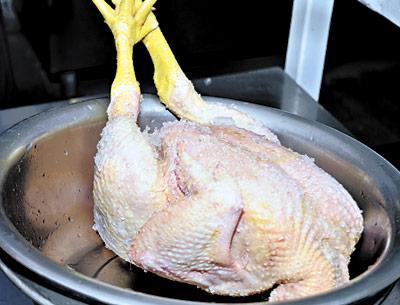Seasons by the Sea: Chicken ‘Raised Up Right’

Chicken is a delicious, economical meat accessible to all. Chickens are filthy, germ-ridden animals we shouldn’t touch. Which do you believe? Both are true. Sadly, chicken “production” in this country has been steered in the same direction as hothouse tomatoes; the desire for more profit and efficiency has produced utterly tasteless, Vegas showgirl-breasted foulish fowl. However, we are very lucky out here having such fine establishments as Iacono Farm in East Hampton and Browder’s Birds in Mattituck, to name just two poultry farms. You may pay a little bit more for these birds but you can be sure they were “raised up right” as we Southerners say, and they taste “chickeny” as Julia Child once said.
Although I don’t eat a lot of meat, I love chicken. Roasting a whole one and making gravy and mashed potatoes to go with it always makes friends and family feel special even though it’s such an easy thing to do. Well made fried chicken is a treat and dishes such as Thai drunken noodles, Chinese kung pao chicken, and Indian curries are perfect ways to enhance this rather bland meat.
I gave up on cheap chicken years ago, brands like Perdue and Tyson and whatever the one is that has Paula Deen’s face on it are just god-awful. For a while I liked Empire Kosher because they have been brined and are tasty. But they’re always covered with a few residual feathers and most often expire before the sale date says they will. Bell and Evans used to be pretty good but even those have tasted dull lately. I strongly suggest you only buy birds from local farms.
Chickens are descended from an aggressive red jungle fowl of northern India and southern China, the Gallus gallus, a member of the pheasant family. They were probably domesticated in the vicinity of Thailand before 750 B.C., and arrived in the Mediterranean around 500 B.C., according to Harold McGee in his book “On Food and Cooking.” They were merely farmyard scavengers until the 19th century when Chinese birds were imported and started a craze of chicken breeding in Europe and North America. Mr. McGee points out that the modern bird is “an impressive feat of agricultural engineering to produce a four-pound bird on eight pounds of feed in six weeks!” The faster they grow, the blander they are.
If you follow some very important rules and suggestions you have no need to ear this dirty bird. If you’re going to buy your bird from the grocery store, put it in an extra plastic bag, don’t want those juices leaking out. Make it the last item in your cart so it remains as cold as possible. At home, store it (and all meats and fish) in the bottom of your refrigerator. Wash your hands after handling raw chicken! Wash the chicken before preparing to cook. Keep all cutting boards and knives scrupulously clean, these can retain bacteria not just for hours but for days. Cook to an internal temperature of at least 165 degrees and use a good meat thermometer.
As for some currently popular language used to describe the chicken you buy, a big percentage of it is total B.S., excuse my almost bad language. “Natural” is a meaningless term; there are no inspections required to verify this. Same goes for “cage-free.” No chickens raised in this country are kept in cages, but there is no assurance they have access to the great outdoors, either. “Free-range” may simply mean that they can go frolic outside on a cement slab for five minutes. They’re still crammed together. The descriptives you do want to see are “no antibiotics,” “no hormones,” “no G.M.O.s,” and “certified humane.” “Pasture-raised” is not a legal definition so it is meaningless unless the label indicates “animal welfare approved.”
And now for a bit more scary news before I share some delicious recipes. Consumer Reports recently conducted tests on more than 300 raw chicken breasts from around the country and regardless of quality, price, or origin, 97 percent harbored bacteria. Every one of the major brands contained “worrisome” amounts of bacteria, these being Tyson, Pilgrim’s, Sanderson Farms, and Perdue. Even those labeled “antibiotic free” contained some inevitable bacteria due to processing. The United States Department of Agriculture is useless in helping with this problem, and is in fact considering new rules that will allow the slaughter of 175 birds per minute (up from 140 per minute), and transferring the duties of its inspectors to the plant’s own employees.
In 2000 Denmark’s pork industry stopped using antibiotics to promote growth of their piggies. Rather than hampering the industry, this contributed to a 50 percent growth in pork production. The success of this action is attributed to the laws banning use of antibiotics, vigilant enforcement, and rules to prevent veterinarians from profiting by selling antibiotics to farmers. Why can’t we do that with our poultry industry? Okay, stepping off of my soapbox now. . . .
The average cost of plain old supermarket chicken breasts is $3.68 per pound, for antibiotic-free it’s about $5.49 per pound, and organic chicken runs about $6.99 per pound. I think you and your family are worth it, don’t you?
Click for recipes
